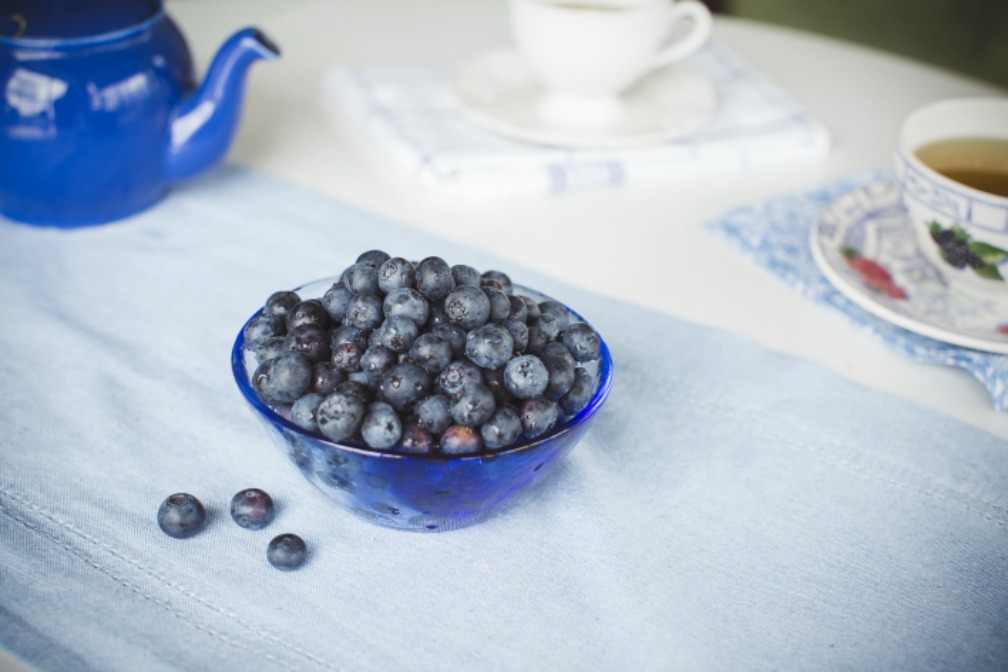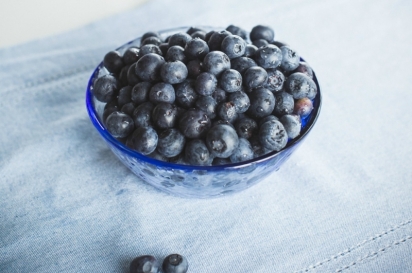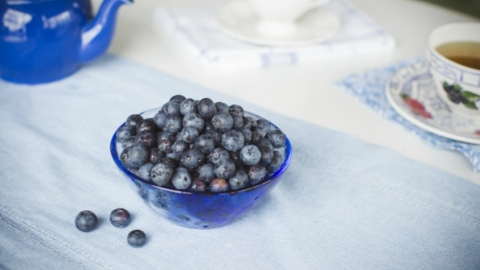New England Blueberries
Is there anything more perfect than a just-picked, ripe blueberry on a sunny day in summer? Blueberries are not only a heralded superfood supposed to prevent everything from cancer to Alzheimer’s but they are also indigenous to North America, which makes them the ultimate paleo and uber-locavore food. I could not care less what lists blueberries make; I love them regardless of any health benefits. Sweet and tangy but not too acidic, if you have a sunny spot in your backyard, it is a cinch to grow them in order to harvest your own from mid-summer till fall.
PLANTING
Native to New England forests, blueberry bushes grow very well in our region. Thornless and with a back-friendly height of four to six feet (for high-bush), they are a delight to cultivate and harvest. Unfortunately birds and deer are big fans, too. More sinister is the spotted-wing drosophila, a recently arrived menace to soft-skinned fruit, which lays its eggs in the berries. There are means of dealing with these pests, however, and by and large, blueberries should be trouble free.
Blueberries must be planted in acidic soil. This is nonnegotiable. When I planted my first plot of 100 bushes, I had the notion to spoil the young transplants by digging out my extremely acidic (pH= 4.2!), lean soil and replacing it with deep rows of lush compost. The plants sat in their plush beds for weeks looking yellow and sickly; most compost being near neutral pH, I was starving them. I learned that blueberries don’t just prefer acidic conditions, they need them to properly absorb nutrients. So a pH of 4.5 to 5 is essential. Lesson learned, I dug up all the plants, returned half of the native soil, replanted them, and they have been thriving ever since.
The best time to plant blueberries is in the spring, but doing bed preparation now will ensure ideal conditions. Choose a site in full sun with good drainage. Loosen the soil; remove all weeds and do a soil test for pH and nutrients. If you need to lower the pH, add granular sulfur. You can also incorporate peat moss, pine needles or coffee grounds to increase organic matter and improve acidity. When you get your plants in the spring, plant them 4 feet apart, allowing space on all sides for good airflow as well as room for picking. If you prepared a bed with healthy soil, there is no need to fertilize the first summer, but give the plants an acid-friendly, well- balanced fertilizer in subsequent years. A happy blueberry plant can be productive for decades, so make the effort up front to give it a good foundation.
Many new growers I know complain that deer browse their young plants back to their starting point each year. If you have a healthy deer population in your area, not to mention birds, you may find a planting pattern that allows for fencing, or draping some netting, for your best shot at a frustration-free blueberry experience. A good option is to plant in a rectangular shape and then place a simple frame around the whole area. For a backyard garden, a pattern of 2 by 3 plants will give you 6 bushes to harvest. You can then build a frame from wood or PVC pipe that is just a bit larger than the planting area and place it around the bushes. When the berries start to ripen, place a large net over the entire frame, which will keep birds and other critters out without getting tangled in the bushes. If the netting is fine enough, it would even work to bar the dreaded spotted-wing drosophila. If deer nibbling is a problem in fall and winter, the frame could also be used to support a seasonaldeer fence that would keep them away, too. The one time to keep the nets off is during flowering season, usually May and June, when the pollinators are at work.
VARIETIES
When it comes time to choosing varieties, ask yourself what you will be using them for. Most berry catalogs are pretty honest about flavor, so don’t even bother with a variety that is described as “mild,” this usually means bland. If you like to cook with blueberries, such as muffins or pancakes, a smaller size berry is a good option. If you want to make quarts of jam and pies, choose a variety that produces bigger fruit, or you will be picking for hours. Pay attention to when they ripen; early season, late season and so forth. If you have enough diver- sity, you can have bushes fruiting from July through September. You do not absolutely need different varieties for cross-pollination, but professional growers agree that more varieties result in higher yields.
My favorite variety is Patriot. It produces a large berry, early mid- season that has the perfect balance of sugar and acid. Hardy to zone 3, they have never let me down in the 15 years I have been growing them. Another variety that I recommend, with reservations, is Chan- dler. Breeders somehow managed the rare feat of creating a berry that is both enormous and has excellent flavor. The berries are commonly the size of quarters with robust blueberry flavor, on the low acid side. The downside of Chandlers is their less-than-great hardiness. They are only recommended for zone 5 and points south. In my somewhat warm zone 4 area, they survive the winter just fine but don’t produce heavily every year. But when I do get them, they are always worthy of a Facebook post since their size is so remarkable.
One last note regarding harvesting: Be patient! Blueberries need to be blue all the way around for them to reach peak flavor. If you see them turning blue, wait another few days before picking them or they will still be sour. Trying to explain this to children can be a challenge, and when you go out picking with them you can end up with bowls full of puckery, half-green fruit that no one is interested in eating. If you are picking with children, tell them to gently look on the backside of the berry and if it is still green, leave it be.
I highly recommend planting your own bushes. Once they are es- tablished, you will enjoy watching the bushes flower and then grow berries that change from green to rose to deep blue. As an added bonus, the bush turns a beautiful scarlet in the fall.
Recommended companies for bare-root blueberry plants
Nourse Farms, Whatley, MA, NourseFarms.com
Fedco, Waterville, ME, FedcoSeeds.com
Elmore Roots, Elmore, VT, ElmoreRoots.com
Three comprehensive websites for pick-your-own operations in Vermont








